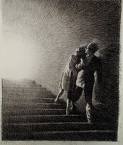Massive expulsion of Haitians living in the DR

BY MICHAEL DEIBERT SPECIAL CORRESPONDENT
OUANAMINTHE, Haiti -- The Dominican Republic carried out a massive expulsion of Haitians living in a remote region last month, forcing thousands to leave behind family members, possessions and jobs, according to UN officials and humanitarian aid workers.
At least 3,500 Haitians living in a broad swath of northwest Dominican Republic were sent back to Haiti. Many were transported on buses under military control and taken by armed soldiers to the border post of Dajabon, where they crossed the bridge over the Massacre river to this Haitian town, humanitarian aid workers here said.
It was a "massive and unexpected influx," said Javier Hernandez, a regional head of the United Nations Stabilization Mission in Haiti.
"People arrived, children without their mothers and their fathers ... parents without their children," said Sister Yolande Duverger at the Sisters of Saint John the Evangelist convent in Ouanaminthe. She estimated that 2,000 expelled Haitians had slept in and around the town's Notre Dame church during the first days of the expulsion.
Statements by Dominican officials, including the president, former New Yorker Leonel Fernandez, indicated the deportation had top-level approval. Asked in mid-May about the expulsion, Fernandez described it as an issue of "sovereignty." Officials at the Dominican Republic diplomatic missions in New York and Washington declined to comment yesterday.
The UN High Commissioner for Refugees formally protested to the Dominican government on May 17 and demanded the expulsions not be repeated. "We were very disturbed by the reports of human rights abuses and family separations," said Janice Marshall, senior regional protection officer in Washington.
While many of the Haitians lacked residence papers, officials of the British charity Christian Aid said those caught up in the operation included a significant number in the Dominican Republic legally. Many reported their documents had been torn up by soldiers before they were forced back into Haiti.
Aid workers on the Haitian side of the border said the expulsions began after the May 8 murder of Dominican businesswoman Maritza Nuñez in Hatillo Palma, 166 miles northwest of the capital, Santo Domingo, for which four Haitian immigrants were blamed.
Lissaint Antoine, director of the Jesuit Service for Refugees and Migrants in this muddy frontier town, first saw Haitians filtering across the border after the murder. Quoting expellees, he said the people of Hatillo Palma began protesting the presence of Haitians and the provincial governor ordered that 400 of them be expelled. Haitians also were forced from the La Vega, Monte Christi and Santiago districts.
He said the number rose on May 11 and reached its height on May 13, when eight buses arrived at the border full of Haitians.
There were numerous reports of violence against Haitians, including murders and house-burnings. "We had a woman who stayed for three days [who] said that her husband had been killed," Antoine told Newsday. Separately, two brothers, 13 and 14, told the Jesuit mission official that Dominican civilians armed with machetes had killed their parents.
Sister Duverger said she heard other accounts "... of men who said their wives had been killed, women who said their husbands had been killed." Aid workers also said the military roughed up the Haitians. "The Dominican army tore up many people's papers at the border," Duverger said. "A lot of people looked like they had been beaten up."
Louis Amelice, the caretaker at her church, concurred. "They said the army had destroyed their documents so they couldn't return," he said. Dominican border guards indirectly confirmed that anti-Haitian violence coincided with the expulsion.
An immigration officer in Dajabon said Dominican authorities did not intentionally expel Haitians with Dominican papers, that when the Haitians "saw what was going on in Hatillo Palma, they fled back to their country. Mothers went back with their children. They went back voluntarily." Another officer said bluntly, "We have too many Haitians in the Dominican Republic." The officers declined to give their names.
Haitian-Dominican relations often have been tense because of their economic and cultural differences. Although they are close in population, with 8.1 million Haitians and 9 million Dominicans, Haiti is 95 percent black, and 80 percent of the population lives in poverty. The Dominican population is 89 percent white or mixed, with 25 percent impoverished. About 500,000 Haitians live in the Dominican Republic, many doing the jobs locals disdain.
Haitians still recall vividly the fall of 1937, when Dominican dictator Rafael Trujillo, motivated by factors that have never been satisfactorily explained, instigated a pogrom in which Dominican soldiers and police massacred 15,000 to 20,000 Haitians throughout the country. The attacks occurred at a particularly furious pace in the region where today's unrest is centered.
Add new comment